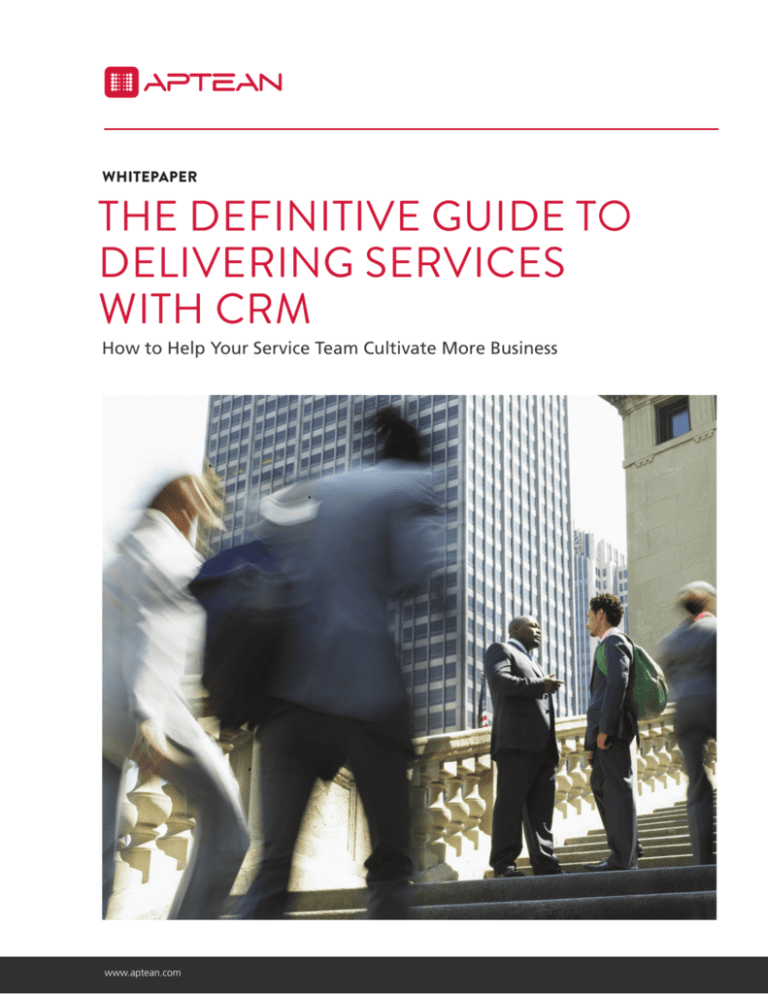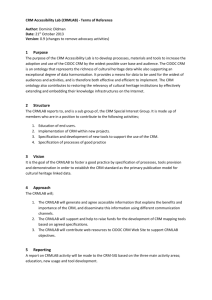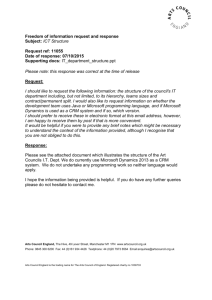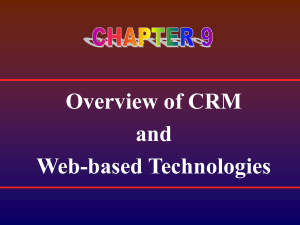
WHITEPAPER
THE DEFINITIVE GUIDE TO
DELIVERING SERVICES
WITH CRM
How to Help Your Service Team Cultivate More Business
www.aptean.com
WHITEPAPER
THE DEFINITIVE GUIDE TO DELIVERING SERVICES WITH CRM
ABOUT
Many organizations consider the function of servicing customers one
way: as a costly necessity. And for many organizations, it’s true. Without
the clear connection to revenue that Marketing and Sales departments
have, Service departments are often seen as cost centers. Performance is
rated in terms of capacity, or how many calls can be closed in a day. Due
to the high cost of service, the goal is to spend the minimum of time and
resources on each customer.
Performance is all about quantity, and increasing the flow of resolution.
But this perspective on service performance is missing something.
What if service could be more than just a cost center? What if it
could be a revenue center? It’s more simple than you might think.
You’re a customer—everyone’s a customer of something. Think of the
organizations you do business with, both the ones that satisfy you and
the ones that leave you cold. What’s the difference?
Chances are good that the deciding factor occurs through your
experience with the organization’s service department. You feel like the
company knows you and appreciates your business—or you don’t. You
have faith that when you call, you’ll get resolution to a problem quickly
and pleasantly—or you won’t. To improve profitability without slashing
budgets, turn a cost-centered call center into a revenue-generating
contact center. Get better at customer interactions in your service
department. Because done well, they hold the key to turning customers
into brand loyalists. Which means they keep coming back to buy more.
www.aptean.com
2
WHITEPAPER
THE DEFINITIVE GUIDE TO DELIVERING SERVICES WITH CRM
THE CONTACT
CENTER: THE NEW
CUSTOMER EPICENTER
The demand is clear. Every time your customers call you for
help, they want to feel remembered. Appreciated. Known.
They want you to give them what they want quickly and
happily, and maybe even give them a little something extra.
A recommendation, a preferred price or a sneak peek at the
newest version of their favorite product.
The traditional call center is going to struggle to provide
that level of service, yet customer expectations only continue
to increase.
3
agents close sales, process orders, develop quotes and gather
feedback on products. Outbound agents segment customers,
generate and qualify leads and calculate marketing ROI.
With the right contact center strategy and application,
companies can:
• Deliver a positive service and brand experience
to customers
• Create proactive interactions with customers
• Reduce costs without sacrificing the quality of service
• Increase revenue with every customer interaction
• Improve key performance indicators
• Outperform larger competitors
Organizations who want to meet demand and exceed
expectations need to take the next step—from call center to
contact center.
• Outmaneuver competitors quickly to take market share
Great customer service is no longer only about providing
phone-based service and support centers. A smart contact
A contact center is what every call center wants to be when
center can significantly improve a company’s top and bottom
it grows up. A fully-formed, efficient interaction machine
line. It’s the epicenter of the customer relationship and it’s
that’s running on all cylinders. Across every customer-reaching
where smart marketing, selling and servicing converge every
function in your company.
day to create satisfied customers and build a positive customer
Just like a call center, a contact center speeds the capture,
and brand experience.
tracking, management, escalation, and resolution of customer
service requests, improving productivity. But a contact center
does it on the foundation of a complete, personalized view of
every customer and their needs and preferences. By unifying
customer data across sales, marketing and service, it delivers
more personalized, ‘one & done’ interactions at lower costs.
THE CUSTOMER
EXPECTATION:
TECHNOLOGY RAISES
THE BAR
It fundamentally transforms the customer experience, because
Companies are starting to realize that with a smart contact
you’ll be able to do business how your customers want to do
center strategy there is a new opportunity to build long-term,
business. Which you’ll find they will like. A lot.
reliable relationships and satisfied customers to drive
Tactical call center agents solve customer problems. Strategic
revenue growth.
contact center agents collaborate seamlessly with sales and
Selling a single product or service is great in the short term,
marketing to generate leads and close sales. In a contact
but the real revenue opportunity is to keep loyal customers
center, agents spend less time per call, increase their volume,
coming back time and time again. That’s the revenue stream
and provide solutions more often on the first call. Inbound
that contact centers can help generate.
www.aptean.com
WHITEPAPER
THE DEFINITIVE GUIDE TO DELIVERING SERVICES WITH CRM
According to Dr. Jon Anton, Contact Center Guru and
and rewarding customer experience across all channels
Director of Benchmark Research at the Center for Customer-
of interaction. To do so, companies must be able to put
Centric Quality at Purdue University, for many companies
a contact center strategy in place that delivers on your
“80 percent of next year’s revenue should come from this
company’s vision for the ideal customer experience, and
year’s customers.” What many companies have lacked
measures the success of this strategy over time.
4
is a cost-effective way to track, build and maintain that
relationship over time so that they can continually identify
Technology advancements have raised the bar for service
MEASURING CUSTOMER
SERVICE SUCCESS
excellence. Amazon.com is a great example of a company
Achieving success in the contact center means improving key
that knows how to keep customers coming back time
performance indicators (KPI) including reducing interaction
and time again. It has set a new standard for the ideal
costs; increasing revenue from interactions; and increasing
customer experience.
customer satisfaction. Improvements in key indicators not
new revenue opportunities with existing customers.
only impact the top and bottom line, but also give companies
When you visit Amazon.com, it’s easy to find what you want
the agility to remain competitive.
online. But your positive customer experience is not limited to
the Web. You receive consistent, personalized service across
all channels. When people have a satisfying service experience
at Amazon.com, it raises their expectations. They believe that
all companies should be able to live up to this level of service.
How to Improve Key Business Performance Indicators
Reduce Interaction Costs
• Choose a CRM-driven contact center system with
Computer Telephony Integration (CTI) to immediately
As consumers, we find ourselves wondering why this level
display screen pops with relevant customer information
of service isn’t available to us when an airline loses our bags.
on the agent’s desktop. The agent is prepared to
When we’re at work, we wonder why we can’t explain to a
answer the call saying, “Hello Mr. Peters, good to hear
valued customer why a much-needed shipment hasn’t been
from you again. How did that adjustment work for you
delivered on time. So, every company must ask, ‘How do we
last week?”
compare against the companies that are already delivering
world-class service?’
The bottom line is that today’s customers expect much
more of the companies they engage with. Contact center
technologies and strategies directly impact an organization’s
ability to deliver on these customer expectations.
• Provide agents with accessibility to the information
they need to handle a call quickly and effectively,
including customer account status, recently received
special promotional offers, or service history on
a particular product
• Ensure quick access to incoming calls with a floating
telephony toolbar on the agent desktop Increase
Innovative corporate leaders are initiating a new conversation
Revenue from Interactions
about customer service. They are asking their leadership
teams, ‘Now that technology can allow us to service our
customers any way we want to, what does our ideal
Increase Revenue from Interactions
• Automate the delivery of tools and information
customer service model look like?’ These corporate leaders
designed to help agents recognize up- and cross-selling
recognize that they have an opportunity to differentiate
opportunities with each customer
from their competitors by delivering on a more compelling
www.aptean.com
WHITEPAPER
THE DEFINITIVE GUIDE TO DELIVERING SERVICES WITH CRM
• Provide agents with dynamic scripting and an easyto-use interface so that they can position additional
products and services without extensive training
Increase Customer Satisfaction
• Personalize customer interactions across every
communication channel
• Provide agents with the knowledge required to give
customers quick, accurate answers including access to
all sales, and marketing related interactions
• Deliver multi-media interaction including phone,
e-mail, Web chat, Web collaboration and VoIP, so that
customers can interact across their preferred channel
of communication
• Automate the routing of customer requests from across
any communication channel to the most qualified
agent—for example, segment and flag most valuable
customers and automatically send to a select group of
senior-level agents each time
• Capture interaction history with screen pops so
that agents don’t have to ask customers to repeat
• Provide one-click access to critical information through
web-based, user-friendly browsers
• Allow agents to easily position additional products and
services with dynamic scripting, eliminating the need for
extensive training
Resolve a Greater Number of Calls on the First
Interaction (‘one-and-done’)
• Deliver quick access to intra-enterprise information
Decrease Call Times
• Create a distributed contact center with technologies
and synchronization tools—ensure that calls are quickly
redirected to other satellite contact centers during peak
call times
Reduce Maintenance Costs
• Select an end-to-end, single vendor solution which
includes a complete CRM suite
• Ensure cost-effective integration, or an all-in-one contact
center infrastructure from a single vendor
• Select a solution with easy-to-use customization tools
information they’ve already provided through Web self-
so that you can quickly make changes as needed,
service or an interactive voice response system (IVR)
on-the-fly
Increase Agent Productivity
• Provide agents with a personalized, intuitive desktop
that consolidates all the tools and information they
need into a single interface
• Give agents the ability to answer inquiries faster
FIVE NEW CRUCIAL
CONTACT CENTER TRENDS
New technology trends in the contact center market are
allowing innovative and opportunistic companies to quickly
with one-click access and desktop integration to
adopt contact center technologies, and outperform the
legacy systems
competition. These trends include:
• Shave valuable time off every call with a floating
telephony toolbar on the desktop that gives agents the
ability to quickly pick up and transfer calls
Reduce Training Costs
• Simplify the service desktop and tailor to your unique
processes, people and products, giving agents an
intuitive, understandable easy-to-navigate interface
www.aptean.com
5
• The Personal Touch (Self-Service Isn’t the Holy Grail)
• The Fast, Easy-to-Customize Contact Center
• The High-Performance ‘Slim Client’ Contact Center
• The Distributed Contact Center
• The Contact Center Meets CRM
WHITEPAPER
THE DEFINITIVE GUIDE TO DELIVERING SERVICES WITH CRM
Trend #1: The Personal Touch (Self-Service isn’t the
performance is at stake. For example, consider a purchasing
Holy Grail)
manager who is trying to secure a price for a product or
In the late 1990s people became enamored with the Internet
service, or an engineer who is trying to obtain a specification
and the idea of self-service. Companies were enthralled with
for a project. If he or she fails—their job performance is
the notion that they could get customers to manage their
questioned. If they can’t make things happen with a vendor,
own service needs through smart, interactive Web sites. This
it reflects on them—as well as the vendor.”
6
would greatly lower the cost of customer service. The theory
worked—to a point.
Trend #2: The Fast, Easy-to-Customize Contact Center
Companies are constantly evolving to capture market and
Many companies have reaped massive benefits by
business opportunities as they arise. As a result, their contact
implementing self-service sites. But even with the major
center technology must be quickly adaptable to business
advantages of self-service technology, there are still
process changes. The challenge is that the business processes
circumstances in which customers need to speak to
inside a contact center are highly defined to ensure efficiency.
a customer service agent for a deeper level of support.
Companies with high-functioning contact centers have
expended significant energy to define the exact steps service
Companies have come to realize that they must integrate
their call/contact center with their self-service capabilities to
manage sophisticated service needs. As a result, personal
customer service through contact center agents has regained
agents must take to resolve common customer problems.
These well-defined processes become a powerful competitive
differentiator allowing the company to keep valued customers
satisfied even when major problems arise.
prominence. And, fast, cost-effective integration has become
a top technical priority.
So, what happens when a new product line is introduced?
Or when the company decides to creatively bundle a set of
Frustration Leads to Emotion
We’ve all experienced 15-minute wait times with slow-service
companies. And we’ve experienced the frustration of not
being able to get solutions to our problems—or having our
problems fall through the cracks.
service offerings to outmaneuver a competitor? To quickly
address new business opportunities, contact centers must be
built on easily customizable software so that service agents
can depend on the technology to accelerate their tasks,
not slow them down. Companies must be able to easily
Customer service issues can be an emotional roller coaster for
customize the agent portal, workflow, and business rules.
the customer—and great companies have the capacity to deal
And they must be able to easily integrate the contact center
with this reality. Problems that occur must be solved in the
application to provide agents with seamless access to other
heat of the moment, or that emotion atrophies and becomes
applications and data sources.
distrust. These magic moments are when companies either
build the customer trust and loyalty they desire, or they lose
loyalty entirely.
Industry analysts also contend that an enterprise’s unique
business processes, especially their customer service
processes, are a significant competitive differentiator. Hurwitz
The hard reality of handling emotional moments holds true
Group recently completed a study on CRM and its findings
in both business-to-consumer and business-to-business
indicated that nearly 80 percent of companies said that they
scenarios. In examining the difference between individual
would customize their applications, and that adaptability
consumer inquiries and B2B inquiries, Dr. Jon Anton notes,
to fit existing business processes was important. To address
“Some people might think that there is little or no emotion
this requirement, enterprises are looking for flexible contact
tied to business-to-business interactions. But this is a myth.
center applications that are both easy to customize and easy
When people are engaging in business interactions, their job
to integrate with intra- and extra-enterprise applications and
www.aptean.com
WHITEPAPER
THE DEFINITIVE GUIDE TO DELIVERING SERVICES WITH CRM
data sources. Contact center flexibility is about making the
is extremely difficult to continually find and train first-rate
contact center software, and the contact center business
customer service representatives.
7
process, work the way the organization requires—not how
the contact center vendor thinks they should work.
Further, customers are demanding round the clock service
availability. To mitigate these challenges, companies are now
Many vendors’ contact center applications are based on
choosing to establish smaller, distributed contact centers
inherently rigid architectures, making the application very
across multiple cities, and multiple geographies. As
difficult to customize and adapt.
a result, mid-sized contact centers of 100 to 250 agents are
a booming trend.
Trend #3: The High-Performance ‘Slim Client’
Contact Center
Companies that realize that their contact center is critical to
Many contact centers turn over their entire workforce
ensuring customer satisfaction want excellent employees to
three to four times a year, creating two massive challenges
staff the center. It is difficult to attract large numbers of high
in workforce management. The first challenge is the cost
quality individuals from a single location, so many companies
of constantly training new agents on the business, service
are forming ‘distributed’ centers that are geographically
processes, and software. The second challenge is moving
disbursed to enlarge the candidate pool and also in many
agents up the productivity curve—it takes time for new users
cases to cover differing time zones.
to become productive and efficient. As a result, companies
face the dilemma of increasing agent productivity while
keeping training costs low.
Industry analysts agree this is an important trend. Dr. Jon
Anton says, “Our studies show that large centers are less
efficient and/or effective as compared to smaller centers.
To address this need, enterprises are looking at ‘Slim Client’
There is a trend to keep centers in the 150- to 250-agent
applications as a way to deliver a rich, interactive user
range, and to spread them out geographically.”
experience—allowing agents to become productive quickly.
With slim client applications, the presentation logic runs on
the client—with no installed code, while the business and
application logic resides on the server.
Trend #5: The Contact Center Meets CRM
Contact centers cannot operate effectively in isolation.
Instead, they must be an integral part of a company’s
overall CRM strategy and they must consolidate customer
This approach provides users with a Web interface that has
interactions from across the organization.
richer functionality and better response times than a pure-thin
client approach, which has the presentation, business and
application logic running on the server.
The contact center typically becomes an answer center— and
when agents are put on the spot to respond to an inquiry, if
the agent doesn’t have the answer, or responds with ‘I don’t
A slim client approach to application deployment provides
know’, customers become very unhappy.
contact center agents with an application that is fast, easy to
use, and productive. Since a Web interface is familiar territory,
especially for less experienced users, agents can engage with
customers in an intelligent, confident way.
Trend #4: The Distributed Contact Center
Managing costs and ensuring reliable service can be daunting
in a thousand-agent contact center. High turnover rates
are a significant challenge for large contact centers—and it
www.aptean.com
The truth of the matter is that many companies are
torturing their customers with poor and often disjointed
customer service.
CRM is a highly effective way to demonstrate to
customers that every business unit across the organization,
including sales, marketing, and service is connected and
interdependent. CRM gives agents the knowledge they need
WHITEPAPER
THE DEFINITIVE GUIDE TO DELIVERING SERVICES WITH CRM
to make changes to the way they treat customers inside
of the contact center based on other activities within
the organization.
Contact centers present a unique opportunity when it comes
8
• 37% improvement in calls resolved on the first
interaction = $326,500
• 27% improvement in caller satisfaction =
$135,000 per year
to customer service, especially in our current economic
This study reinforces that a contact center strategy must
environment. With so many enterprises under intense
be set within a larger CRM strategy to be highly effective.
customer scrutiny, companies can use their service advantage
Agents must be able to leverage the full sales, marketing and
to increase customer loyalty and win new customers. Now
service capabilities of a CRM suite to intelligently interact and
more than ever, companies should be optimizing their
have compelling dialogues with customers.
contact center to take advantage of this opportunity.
This is absolutely critical because customers fully expect
In the last five years, customer service has become a primary
that every customer-facing employee in the organization
corporate focus—it is an imperative for market success. To
will understand everything about them. And, since up-sell
take care of customers, companies need customer-centric
and cross-sell opportunities are predominately presented to
processes, systems and capabilities—and that’s ultimately
agents during an inbound call, it makes sense to equip agents
what CRM is all about.
with the right tools and information to make compelling
The Center for Customer-Centric Quality at Purdue University
embarked on a study of thousands of contact centers with
offers for products and services. These conversations will
absolutely lead to increased revenue in the long term.
the objective of determining the value of CRM in the contact
An End-to-End Single Vendor Solution
center. They compared companies with contact centers that
Companies should no longer tolerate the complexities and
had implemented CRM with companies that had not.
shortfalls of a multi-vendor solution to meet their complete
The study concluded that companies with both a contact
center and CRM deployment had significant improvement in:
CRM and contact center requirements. Instead, look for
a single vendor to provide an end-to-end solution that
includes infrastructure, multimedia channels, CRM, and
• The number of calls handled per shift, per agent
a single interface. Patching together divergent solutions from
• The average handle time per inbound call (in minutes)
multiple vendors is a much more unpredictable exercise,
• The percentage of calls resolved on the first interaction
• Caller satisfaction
requiring expandable budgets and resources,as well as a high
tolerance for risk. Look for one, complete, unified solution
that is sensible, standards-based, and cost-effective.
The Center for Customer-Centric Quality then calculated
Given that contact centers never operate in isolation, contact
the financial impact of a CRM implementation on a contact
center software needs to be integrated to other data stores
center with 250 agents1. Based on their calculations, they
and transactional systems throughout the enterprise. Agents
concluded that if a company deploys a CRM solution, the call
may need to open a service request, place an order, manage
center would achieve:
inventories, or access billing information—information that is
• 44% improvement in calls per agent per shift =
$225,000 per year
• 38% improvement in the average handle time =
$177,000 per year
often contained within other business systems.
Contact center integration with other enterprise applications
is usually the major cost overrun in a contact center
implementation, so companies are looking for sensible
solutions that mitigate the time, cost and risk of integration.
www.aptean.com
WHITEPAPER
THE DEFINITIVE GUIDE TO DELIVERING SERVICES WITH CRM
SUMMARY
It’s time for us to shift our thinking. It’s time to shake off the
cost-intense reputation of service, and consider the possibility
that our service teams can more than earn their keep, given
the right tools.
Service today is driven by the new reign of the contact
center. And the reign of the contact center is driven by five
key trends: the need for a personal touch with customers,
the need for fast, easy customization, slim-client platforms,
distributed set-up, and of course, the need for close
Gone is the traditional role of the agent as a problem-solver,
responsible for just one aspect of the customer relationship.
Now, agents market. They sell. They transform themselves
from cost-producing to revenue-producing. All while
improving the quality of the customer experience.
When a service team becomes profitable, the focus changes
from solving problems to creating brand loyalists. And when
customers feel good about doing business with you, you’ll
see it impact the bottom line. Because they’ll be coming back
to buy more.
integration with a complete CRM system.
1. Based on average agent annual wages.
More than 9,000 customers around the world rely on us to give them a competitive edge. By
providing innovative, industry-driven enterprise application software, Aptean helps businesses
to satisfy their customers, operate most efficiently, and stay at the forefront of their industry.
For more information, visit: www.aptean.com
www.aptean.com
9
Copyright © Aptean 2012. All rights reserved.










